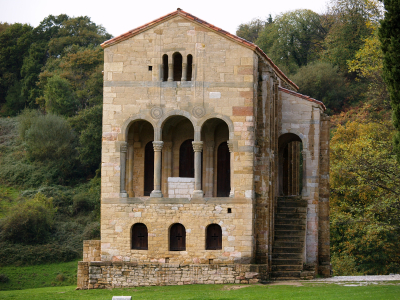Introduction to the Principality of Asturias
This is the Celtic heart of Spain, its wet climate making it a focal point for dairy production
 One of the smallest of Spain’s seventeen Autonomous Communities, Asturias occupies an area of a little over 4,000 square miles on the northern Atlantic coast of the country, and is home to just over a million people. Half of these live in the two major cities of Gijón and Oviedo, the regional capital; there is no provincial sub-division within Asturias.
One of the smallest of Spain’s seventeen Autonomous Communities, Asturias occupies an area of a little over 4,000 square miles on the northern Atlantic coast of the country, and is home to just over a million people. Half of these live in the two major cities of Gijón and Oviedo, the regional capital; there is no provincial sub-division within Asturias.
This part of the country is very different from the stereotypical image some of us have in mind when thinking of Spain: the countryside is green and the climate, although warm, is wet. The 30% of the region which is protected under national park status includes the Picos De Europa mountain range, which climbs to almost 2,700 metres above sea level and forms a natural boundary with Castilla y León to the south. These mountains were given their name by voyagers returning from America, for whom the peaks of Naranjo de Bulmes and Torre de Ceredo were reputedly the first land sighted, and between the central and western massifs is a gorge (“Garganta del Cares”) which is one mile deep.
 The 345-kilometre coastline on the Bay of Biscay is rugged, featuring hundreds of coves and beaches, abrupt cliffs and dozens of small rivers and streams: in some respects the visitor could be forgiven for mistaking it for Cornwall!
The 345-kilometre coastline on the Bay of Biscay is rugged, featuring hundreds of coves and beaches, abrupt cliffs and dozens of small rivers and streams: in some respects the visitor could be forgiven for mistaking it for Cornwall!
In prehistoric times the area was inhabited by Celtic tribes (again, Asturias is similar to Cornwall in this respect), many of whom left cave paintings and other remnants of their culture during the Bronze Age. Indeed this area has much in common with other Celtic domains, and the most traditional musical instrument of Asturias is still the bagpipes, often accompanied by hand-drums and accordions.


Trade between Europe and America ensured continued prosperity in the ports of Gijón and Avilés, and both cities’ architecture still includes baroque and Renaissance palaces which bear testimony to their importance in the past, as they served not only their own populations but also that of Oviedo, which lies approximately 25 kilometres inland. Many of those who returned from the New Continent after making their fortune settled in this area.

For centuries the pilgrims passing through Asturias on their way to Santiago de Compostela, in Galicia, have been one of the bases of the region’s tourist industry, alongside the mountains and the beaches: while the winters are cool and wet, the summers are invariably warm without reaching the temperatures of the 
Another route now attracting growing numbers of visitors is the “Ruta del Prerrománico”, which features fourteen religious buildings over a thousand years old, chosen to exemplify the way in which Christian architecture developed while the Moors ruled most of the rest of the peninsula. Among the churches and convents included in the route are buildings in Oviedo, Santullano, Bendones, Pola de Lena, Llanera, Santo Adriano, Pravia, San Pedro de Ambás-Villaviciosa, Villaviciosa and Colunga. The nature of the terrain also makes it a perfect destination for walkers who don’t need a themed route, preferring to explore some of the wildest landscapes in western Europe on their own.


The two main cities are host to a number of museums and cultural events, Avilés boasts impressive Romanesque architecture, and the national parks and stunning mountain lakes are among the most popular destinations for visitors from other parts of Spain. One of the most visited vocations is Covadonga, where it is reputed that in 722 the Asturian warriors were blessed by an apparition of the Virgin Mary before repelling the Moorish invaders, and in many other locations the prehistoric cave paintings are an additional attraction.

In short, this is not the Spain of paellas and bull-fighting, of flamenco and Arab palaces. This is a green, Celtic country which resisted the attempts of the Moors to extend their kingdom, which drew wealth from the Americas to Spain and which links the economic and cultural development of the country to that of the rest of northern Europe as well as to Rome and North Africa. Visitors from cooler climes will feel at home here in some ways, as the cultural heritage which defines Asturias today is shared by many other parts of Europe, although of course the area is indisputably Spanish: a visit to the Semana Grande fiestas in Gijón during 
The comarcas of Asturias are Avilés, Caudal, Eo-Navia, Gijón, Nalón, Narcea Oriente and Oviedo, and apart from Oviedo and Gijón the other main towns are Avilés, Cangas de Onís, Cangas del Narcea, Gozón, Grado, Langreo, Llanera, Laviana, Lena, Llanes, Mieres, Siero, Valdés, Vegadeo and Villaviciosa.
Where is Asturias?
Click for map, Asturias, Spain




























